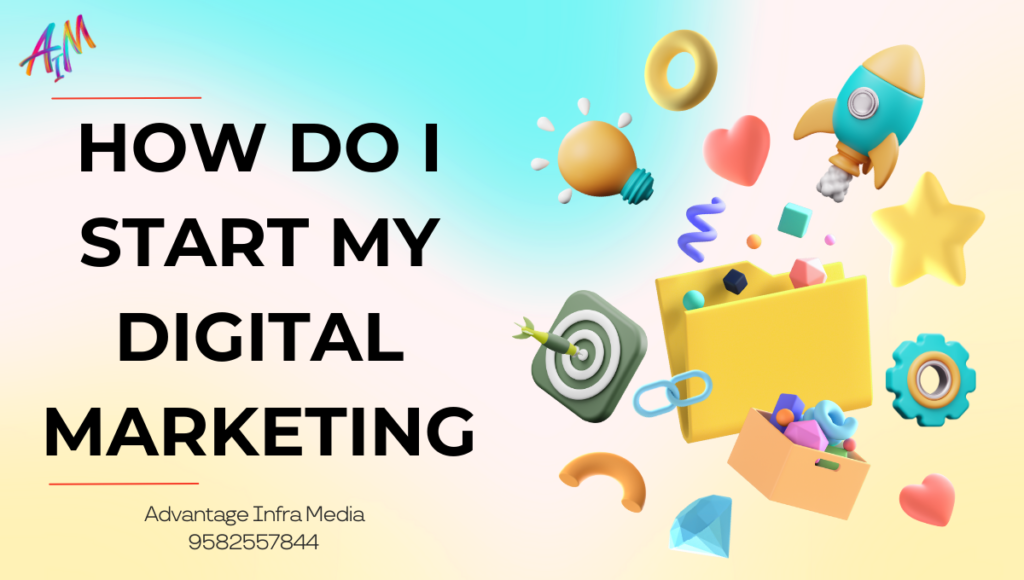Introduction
Digital marketing has become an essential component of modern business strategy. Whether you’re a small business owner, a budding entrepreneur, or a marketer looking to expand your skill set, understanding digital marketing is crucial for success in today’s online world. This comprehensive guide will walk you through the steps to start your digital marketing journey, covering everything from the basics to advanced strategies. (How do I start my digital marketing in 2024)
Understanding Digital Marketing
What is Digital Marketing?
Digital marketing encompasses all marketing efforts that use an electronic device or the internet. Businesses leverage digital channels such as search engines, social media, email, and websites to connect with current and prospective customers.
Why is Digital Marketing Important?
- Reach a Larger Audience: Unlike traditional marketing methods, digital marketing allows you to reach a global audience. This is particularly beneficial for businesses looking to expand beyond their local markets.
- Cost-Effective: Digital marketing often requires less investment than traditional marketing. With the ability to target specific audiences, businesses can optimize their marketing budgets.
- Measurable Results: Digital marketing provides data and analytics that help measure the effectiveness of campaigns in real-time, allowing for adjustments to improve performance.
- Enhanced Engagement: Digital platforms facilitate direct interaction with customers, fostering relationships and building brand loyalty.
Getting Started with Digital Marketing
Step 1: Define Your Goals
Before diving into digital marketing, it’s crucial to define your goals. What do you hope to achieve? Common objectives include:
- Increasing brand awareness
- Generating leads
- Driving sales
- Enhancing customer engagement
- Growing a social media following
Step 2: Identify Your Target Audience
Understanding your target audience is essential for effective digital marketing. Consider the following aspects:
- Demographics: Age, gender, income level, education, etc.
- Psychographics: Interests, hobbies, values, lifestyles, etc.
- Behavioral Data: Purchasing behavior, website activity, engagement levels, etc.
Step 3: Develop a Digital Marketing Strategy
A well-thought-out strategy serves as a roadmap for your digital marketing efforts. Your strategy should include:
- Market Research: Analyze your competitors and industry trends.
- Value Proposition: Clearly define what sets your product or service apart from the competition.
- Marketing Channels: Choose the digital channels that best align with your goals and audience.
Key Components of Digital Marketing
1. Search Engine Optimization (SEO)
SEO involves optimizing your website to rank higher in search engine results pages (SERPs). This increases organic (non-paid) traffic to your site. Key SEO practices include:
- Keyword Research: Identify and use relevant keywords that your audience is searching for.
- On-Page SEO: Optimize elements on your website, such as titles, meta descriptions, headers, and content.
- Off-Page SEO: Build backlinks from reputable sites to increase your site’s authority.
- Technical SEO: Ensure your website is fast, mobile-friendly, and easy to navigate.
2. Content Marketing
Content marketing focuses on creating and distributing valuable, relevant content to attract and engage your target audience. This can include:
- Blog Posts: Regularly updated articles that provide useful information.
- Ebooks and Whitepapers: In-depth resources that offer valuable insights.
- Infographics: Visual content that simplifies complex information.
- Videos: Engaging and informative videos to capture audience attention.
3. Social Media Marketing
Social media platforms are powerful tools for reaching and engaging with your audience. Key social media strategies include:
- Content Creation: Develop a content calendar to ensure consistent posting.
- Engagement: Interact with followers by responding to comments and messages.
- Paid Advertising: Use targeted ads to reach specific demographics.
- Analytics: Monitor performance metrics to optimize your strategy.
4. Email Marketing
Email marketing involves sending targeted messages to your subscribers. It’s an effective way to nurture leads and maintain customer relationships. Key tactics include:
- Building a List: Use lead magnets, such as free ebooks or discounts, to grow your email list.
- Segmentation: Divide your list into segments based on demographics or behavior for more personalized messaging.
- Automation: Set up automated email sequences to guide subscribers through the customer journey.
- Analytics: Track open rates, click-through rates, and conversions to improve your campaigns.
5. Pay-Per-Click (PPC) Advertising
PPC advertising involves paying for each click on your ads, typically through platforms like Google Ads or social media networks. Key PPC strategies include:
- Keyword Research: Identify high-performing keywords for your ads.
- Ad Creation: Write compelling ad copy and design eye-catching visuals.
- Targeting: Use demographic, geographic, and behavioral targeting to reach your ideal audience.
- Analytics: Monitor ad performance and adjust bids, targeting, and creatives as needed.
6. Influencer Marketing
Influencer marketing leverages individuals with a large following to promote your brand. This can enhance credibility and reach. Key steps include:
- Identifying Influencers: Find influencers who align with your brand values and audience.
- Building Relationships: Engage with influencers and propose collaboration opportunities.
- Campaign Management: Coordinate campaigns and monitor results to ensure alignment with your goals.
7. Affiliate Marketing
Affiliate marketing involves partnering with individuals or businesses who promote your products in exchange for a commission. Key components include:
- Finding Affiliates: Recruit affiliates who have a strong online presence and relevant audience.
- Setting Up a Program: Provide affiliates with marketing materials and track their performance.
- Managing Relationships: Maintain communication with affiliates to ensure ongoing success.
8. Web Analytics
Web analytics tools, such as Google Analytics, help you measure and analyze the performance of your digital marketing efforts. Key metrics to monitor include:
- Traffic Sources: Understand where your visitors are coming from.
- User Behavior: Analyze how users interact with your site.
- Conversion Rates: Measure the percentage of visitors who take a desired action.
- Return on Investment (ROI): Calculate the profitability of your marketing efforts.
Building Your Digital Marketing Toolbox
Essential Tools for Digital Marketing
To succeed in digital marketing, you’ll need a range of tools to streamline and enhance your efforts. Here are some must-have tools:
- SEO Tools: Google Search Console, SEMrush, Ahrefs, Moz
- Content Management Systems (CMS): WordPress, Joomla, Drupal
- Social Media Management: Hootsuite, Buffer, Sprout Social
- Email Marketing: Mailchimp, Constant Contact, ConvertKit
- PPC Advertising: Google Ads, Facebook Ads Manager
- Web Analytics: Google Analytics, Adobe Analytics
- Design Tools: Canva, Adobe Creative Cloud
- CRM Software: HubSpot, Salesforce
Learning Resources
Digital marketing is an ever-evolving field, so continuous learning is essential. Here are some resources to keep you updated:
- Online Courses: Coursera, Udemy, LinkedIn Learning
- Blogs and Websites: Moz Blog, HubSpot Blog, Neil Patel’s Blog
- Webinars and Podcasts: DigitalMarketer Webinars, Social Media Examiner Podcast
- Certifications: Google Analytics Certification, HubSpot Inbound Marketing Certification
Advanced Digital Marketing Strategies
Personalization
Personalization involves tailoring your marketing messages to individual users based on their behavior, preferences, and demographics. This can significantly improve engagement and conversion rates.
Marketing Automation
Marketing automation uses software to automate repetitive marketing tasks, such as email campaigns, social media posting, and ad management. This allows for more efficient and effective marketing.
Retargeting
Retargeting involves showing ads to users who have previously visited your website but did not convert. This keeps your brand top of mind and encourages them to return and complete the desired action.
Conversion Rate Optimization (CRO)
CRO focuses on improving the percentage of website visitors who take a desired action, such as making a purchase or filling out a form. This involves testing different elements of your site, such as headlines, calls-to-action, and layouts.
Data-Driven Marketing
Data-driven marketing uses data and analytics to inform and optimize marketing strategies. By leveraging insights from customer data, businesses can make more informed decisions and improve campaign performance.
Measuring Success and Adjusting Strategies
Key Performance Indicators (KPIs)
To measure the success of your digital marketing efforts, track the following KPIs:
- Traffic: Number of visitors to your website.
- Engagement: Likes, shares, comments, and other interactions on social media and blog posts.
- Conversion Rate: Percentage of visitors who take a desired action.
- Customer Acquisition Cost (CAC): Cost to acquire a new customer.
- Customer Lifetime Value (CLV): Total revenue expected from a customer over their lifetime.
- Return on Investment (ROI): Profitability of your marketing efforts.
Analyzing and Adjusting
Regularly review your KPIs and analytics to assess the performance of your digital marketing campaigns. Use this data to make informed adjustments and optimize your strategies for better results. (How do I start my digital marketing in 2024)
Conclusion
Starting your digital marketing journey can seem daunting, but with the right approach and tools, you can effectively reach and engage your target audience. By defining your goals, understanding your audience, and leveraging various digital marketing strategies, you’ll be well on your way to success. Remember to continuously learn, measure your results, and adapt your strategies to stay ahead in the ever-evolving digital landscape.




